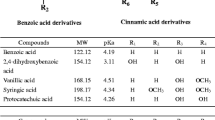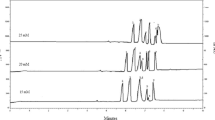Abstract
In this study, we optimized a method for the determination of free amino acids in Nicotiana tabacum leaves. Capillary electrophoresis with contactless conductivity detector was used for the separation of 20 proteinogenic amino acids in acidic background electrolyte. Subsequently, the conditions of extraction with HCl were optimized for the highest extraction yield of the amino acids because sample treatment of plant materials brings some specific challenges. Central composite face-centered design with fractional factorial design was used in order to evaluate the significance of selected factors (HCl volume, HCl concentration, sonication, shaking) on the extraction process. In addition, the composite design helped us to find the optimal values for each factor using the response surface method. The limits of detection and limits of quantification for the 20 proteinogenic amino acids were found to be in the order of 10−5 and 10−4 mol l−1, respectively. Addition of acetonitrile to the sample was tested as a method commonly used to decrease limits of detection. Ambiguous results of this experiment pointed out some features of plant extract samples, which often required specific approaches. Suitability of the method for metabolomic studies was tested by analysis of a real sample, in which all amino acids, except for L-methionine and L-cysteine, were successfully detected. The optimized extraction process together with the capillary electrophoresis method can be used for the determination of proteinogenic amino acids in plant materials. The resulting inexpensive, simple, and robust method is well suited for various metabolomic studies in plants. As such, the method represents a valuable tool for research and practical application in the fields of biology, biochemistry, and agriculture.




Similar content being viewed by others
References
Doubnerová V, Ryšlavá H. What can enzymes of C4 photosynthesis do for C3 plants under stress? Plant Sci. 2011;180:575–83.
Tschoep H, Gibon Y, Carillo P, Armengaud P, Szecowka M, Adriano NN, et al. Adjustment of growth and central metabolism to a mild but sustained nitrogen-limitation in Arabidopsis. Plant Cell Environ. 2009;32:300–18.
Dubois F, Tercé-Laforgue T, Gonzalez-Moro M-B, Estavillo J-M, Sangwan R, Gallias A, et al. Glutamate dehydrogenase in plants: is there a new story for an old enzyme? Plant Physiol Biochem. 2003;41:565–76.
Manaenkov OV, Sidorov AI, Sulman EM. Rapid determination of amino acids by capillary electrophoresis without preliminary derivatization. J Anal Chem. 2003;58:979–82.
Fu GN, He YZ, Wang L, Wang XK. Determination of amino acids in tobacco samples by capillary electrophoresis/indirect absorbance detection with isolation of the electrolysis compartment and p-aminobenzoic acid as a background electrolyte. Anal Sci. 2006;22:883–7.
Shen D, Yaolong L, Zhang Z, Zhang P, Kang Q. Determination of amino acids by capillary electrophoresis with differential resonant contactless conductivity detector. Talanta. 2013;104:39–43.
Coufal P, Zuska J, van de Goor T, Smith V, Gaš B. Separation of twenty underivatized essential amino acids by capillary zone electrophoresis with contactless conductivity detection. Electrophoresis. 2003;24:671–7.
Colnaghi Simionato AV, Moraes EP, Tavares M, Kenndler E. Determination of amino acids by capillary electrophoresis-electrospray ionization-mass spectrometry: an evaluation of different protein hydrolysis procedures. Electrophoresis. 2008;29:2051–8.
Tůma P, Málková K, Samcová E, Štulík K. Rapid monitoring of arrays of amino acids in clinical samples using capillary electrophoresis with contactless conductivity detection. J Sep Sci. 2010;33:2394–401.
Yanqiu J, Baolin Z, Xiuxiu Y, Yuzhen G, Ping L, Weifeng W, et al. Determination of free amino acids in burley tobaco by high performance liquid chromatography. Saudi J Biol Sci. 2016;23:864–8.
Galba J, Michalicova A, Parrak V, Novak M, Kovac A. Quantitative analysis of phenylalanine, tyrosine, tryptophan and kynurenine in rat model for tauopathies by ultra-high performance liquid chromatography with fluorescence and mass spectrometry detection. J Pharm Biomed. 2016;117:85–90.
Zheng G, Jin W, Fan P, Feng X, Bai Y, Tao T, et al. A novel method for detecting amino acids derivatized with phenyl isothocyanate by high-performance liquid chromatography-electrospray ionization mass spectrometry. Int J Mass Spectrom. 2015;392:1–6.
Krumpochova P, Bruyneel B, Molenaar D, Koukou A, Wuhrer M, Niessen WMA, et al. Amino acid analysis using chromatography-mass spectrometry: an inter platform comparison study. J Pharm Biomed. 2015;114:398–407.
Sato S, Yanagisawa S. Capillary electrophoresis-electrospray ionization-mass spectrometry using fused silica capillaries to profile anionic metabolites. Metabolomics. 2010;6:529–40.
Concha-Herrera V, Lerma-García MJ, Herrero-Martínez JM, Simó-Alfonso EF. Classification of vegetable oils according to their botanical origin using amino acid profiles established by high performance liquid chromatography with UV-vis detection: a first approach. Food Chem. 2010;120:1149–54.
Yahaya YA, Don MM. Flavonoid production by T. lactinea: screening of culture conditions via OFAT and optimization using response surface methodology (RSM). J Korean Soc Appl Biol Chem. 2014;57:749–57.
Seenuvasan M, Kumar KS, Kumar MA, Iyyappan J, Suganthi JRG. Response surface estimation and canonical quantification for the pectin degrading Fe3O4-SiO2-nanobiocatalyst fabrication. Int J ChemTech Res. 2014;6:3618–27.
Mohamed N, Yusof F. Experimental design and statistical analysis of protein buffer to purify hydrolases from the skim latex of Hevea brasiliensis. Adv Environ Biol. 2014;8:672–9.
Leardi R. Experimental design in chemistry: a tutorial. Anal Chim Acta. 2009;652:161–72.
Ferey L, Delaunay N, Rutledge DN, Huertas A, Raoul Y, Gareil P, et al. Use of response surface methodology to optimize the simultaneous separation of eight polycyclic aromatic hydrocarbons by capillary zone electrophoresis with laser-induced fluorescence detection. J Chromatogr A. 2013;1302:181–90.
Ortega N, Albillos SM, Busto MD. Application of factorial design and response surface methodology to the analysis of bovine caseins by capillary zone electrophoresis. Food Control. 2003;14:307–15.
Capella-Peiro ME, Bose D, Rubert MF, Esteve-Romero J. Optimization of a capillary zone electrophoresis method by using a central composite factorial design for the determination of codeine and paracetamol in pharmaceuticals. J Chromatogr B. 2006;839:95–101.
Lomasney AR, Guillo C, Sidebottom AM, Roper MG. Optimization of capillary electrophoresis conditions for a glucagon competitive immunoassay using response surface methodology. Anal Bioanal Chem. 2009;394:313–9.
Bezerra MA, Santelli RE, Oliveira EP, Villar LS, Escaleira LA. Response surface methodology (RSM) as a tool for optimization in analytical chemistry. Talanta. 2008;76:965–77.
Carrera C, Ruiz-Rodriguez A, Palma M, Barroso CG. Ultrasound-assisted extraction of amino acids from grapes. Ultrason Sonochem. 2015;22:499–505.
Mustafa A, Aman P, Andersson R, Kamal-Eldin A. Analysis of free amino acids in cereal products. Food Chem. 2007;105:317–24.
Carpena-Ruiz R, Sopena A, Ramon AM. Extraction of free amino acids from tomato leaves. Plant Soil. 1989;119:251–4.
Zhou W, Zhang XY, Duan GL. Liquid-chromatography quantitative analysis of 20 amino acids after derivatization with FMOC-Cl and its application to different origin Radix isatidis. J Chin Chem Soc. 2011;58:509–15.
Wang L, Xu R, Hu B, Li W, Sun Y, Tu Y, et al. Analysis of free amino acids in Chinese teas and flower of tea plant by high performance liquid chromatography combined with solid-phase extraction. Food Chem. 2010;123:1259–66.
Shihabi ZK. Transient pseudo-isotachophoresis for sample concentration in capillary electrophoresis. Electrophoresis. 2002;23:1612–7.
Tůma P, Samcová E, Andělová K. Determination of free amino acids and related compounds in amniotic fluid by capillary electrophoresis with contactless conductivity detection. J Chromatogr B. 2006;839:12–8.
Tůma P, Soukupová M, Samcová E, Štulík K. A determination of submicromolar concentrations of glycine in periaqueductal gray matter microdialyzates using capillary zone electrophoresis with contactless conductivity detection. Electrophoresis. 2009;30:3436–41.
Acknowledgements
This work was supported by Charles University, projects SVV and UNCE 204025/2012, and by OP VaVpI project CZ.1.05/4.1.00/16.0347. The authors are thankful to Mgr. Miroslava Bursová for her assistance with the design of experiments.
Author information
Authors and Affiliations
Corresponding author
Ethics declarations
Conflict of interest
The authors declare that they have no conflict of interest.
Electronic supplementary material
Below is the link to the electronic supplementary material.
ESM 1
(PDF 78 kb)
Rights and permissions
About this article
Cite this article
Hodek, O., Křížek, T., Coufal, P. et al. Design of experiments for amino acid extraction from tobacco leaves and their subsequent determination by capillary zone electrophoresis. Anal Bioanal Chem 409, 2383–2391 (2017). https://doi.org/10.1007/s00216-017-0184-2
Received:
Revised:
Accepted:
Published:
Issue Date:
DOI: https://doi.org/10.1007/s00216-017-0184-2




